I updated the graphing solution from this answer to add zooming functionality:
To add interactive zooming I added a handler for the scroll event. In the scroll event handler, I calculate new values for low and high values for axes and plot coordinates, then apply them to the axes and plot.
I use the scroll event handler that works on the mouse scroll wheel or touchpad or touchscreen scroll gestures. But you could also (or instead) use a zoom event handler that utilizes zoom (pinching) gestures on touch surfaces.
When a scroll is detected, I just zoom in or out on a fixed amount (10% of the current zoom factor) up to a min or max zoom value. A more sophisticated solution could query the delta values of the scroll or zoom events to achieve inertial scrolling and greater or less scrolling based on the speed of the scroll event.
To implement the zoom, I recreate the zoomed nodes rather than updating the properties of existing nodes, which is probably not all that efficient. But, in the simple test case I had, performance seemed fine so I didn't think it was worth additional effort to optimize.
This is just one of the numerous potential solution strategies for this question (I won't discuss other potential solutions here). The particular solution offered in this answer appeared to be a good fit for me.
Also, note that this solution does not use a canvas, it is based on a scene graph. I recommend using the scene graph for this task, though you could use a canvas if you wish. With a canvas solution, the solution might be quite different from the one presented here (I don't offer any advice on how to create a canvas-based solution).
Event handler for handling the zoom
This handler is attached to the parent pane which holds the graph node children.
private class ZoomHandler implements EventHandler<ScrollEvent> {
private static final double MAX_ZOOM = 2;
private static final double MIN_ZOOM = 0.5;
private double zoomFactor = 1;
@Override
public void handle(ScrollEvent event) {
if (event.getDeltaY() == 0) {
return;
} else if (event.getDeltaY() < 0) {
zoomFactor = Math.max(MIN_ZOOM, zoomFactor * 0.9);
} else if (event.getDeltaY() > 0) {
zoomFactor = Math.min(MAX_ZOOM, zoomFactor * 1.1);
}
Plot plot = plotChart(zoomFactor);
Pane parent = (Pane) event.getSource();
parent.getChildren().setAll(plot);
}
}
Sample zoomed chart images
zoomed all the way out

default zoom level

zoomed all the way in

Complete sample solution code
import javafx.application.Application;
import javafx.beans.binding.Bindings;
import javafx.event.EventHandler;
import javafx.geometry.*;
import javafx.scene.Scene;
import javafx.scene.chart.NumberAxis;
import javafx.scene.input.ScrollEvent;
import javafx.scene.layout.*;
import javafx.scene.paint.Color;
import javafx.scene.shape.*;
import javafx.stage.Stage;
import java.util.function.Function;
public class ZoomableCartesianPlot extends Application {
public static void main(String[] args) {
launch(args);
}
@Override
public void start(final Stage stage) {
Plot plot = plotChart(1);
StackPane layout = new StackPane(
plot
);
layout.setPadding(new Insets(20));
layout.setStyle("-fx-background-color: rgb(35, 39, 50);");
layout.setOnScroll(new ZoomHandler());
stage.setTitle("y = \u00BC(x+4)(x+1)(x-2)");
stage.setScene(new Scene(layout, Color.rgb(35, 39, 50)));
stage.show();
}
private Plot plotChart(double zoomFactor) {
Axes axes = new Axes(
400, 300,
-8 * zoomFactor, 8 * zoomFactor, 1,
-6 * zoomFactor, 6 * zoomFactor, 1
);
Plot plot = new Plot(
x -> .25 * (x + 4) * (x + 1) * (x - 2),
-8 * zoomFactor, 8 * zoomFactor, 0.1,
axes
);
return plot;
}
class Axes extends Pane {
private NumberAxis xAxis;
private NumberAxis yAxis;
public Axes(
int width, int height,
double xLow, double xHi, double xTickUnit,
double yLow, double yHi, double yTickUnit
) {
setMinSize(Pane.USE_PREF_SIZE, Pane.USE_PREF_SIZE);
setPrefSize(width, height);
setMaxSize(Pane.USE_PREF_SIZE, Pane.USE_PREF_SIZE);
xAxis = new NumberAxis(xLow, xHi, xTickUnit);
xAxis.setSide(Side.BOTTOM);
xAxis.setMinorTickVisible(false);
xAxis.setPrefWidth(width);
xAxis.setLayoutY(height / 2);
yAxis = new NumberAxis(yLow, yHi, yTickUnit);
yAxis.setSide(Side.LEFT);
yAxis.setMinorTickVisible(false);
yAxis.setPrefHeight(height);
yAxis.layoutXProperty().bind(
Bindings.subtract(
(width / 2) + 1,
yAxis.widthProperty()
)
);
getChildren().setAll(xAxis, yAxis);
}
public NumberAxis getXAxis() {
return xAxis;
}
public NumberAxis getYAxis() {
return yAxis;
}
}
class Plot extends Pane {
public Plot(
Function<Double, Double> f,
double xMin, double xMax, double xInc,
Axes axes
) {
Path path = new Path();
path.setStroke(Color.ORANGE.deriveColor(0, 1, 1, 0.6));
path.setStrokeWidth(2);
path.setClip(
new Rectangle(
0, 0,
axes.getPrefWidth(),
axes.getPrefHeight()
)
);
double x = xMin;
double y = f.apply(x);
path.getElements().add(
new MoveTo(
mapX(x, axes), mapY(y, axes)
)
);
x += xInc;
while (x < xMax) {
y = f.apply(x);
path.getElements().add(
new LineTo(
mapX(x, axes), mapY(y, axes)
)
);
x += xInc;
}
setMinSize(Pane.USE_PREF_SIZE, Pane.USE_PREF_SIZE);
setPrefSize(axes.getPrefWidth(), axes.getPrefHeight());
setMaxSize(Pane.USE_PREF_SIZE, Pane.USE_PREF_SIZE);
getChildren().setAll(axes, path);
}
private double mapX(double x, Axes axes) {
double tx = axes.getPrefWidth() / 2;
double sx = axes.getPrefWidth() /
(axes.getXAxis().getUpperBound() -
axes.getXAxis().getLowerBound());
return x * sx + tx;
}
private double mapY(double y, Axes axes) {
double ty = axes.getPrefHeight() / 2;
double sy = axes.getPrefHeight() /
(axes.getYAxis().getUpperBound() -
axes.getYAxis().getLowerBound());
return -y * sy + ty;
}
}
private class ZoomHandler implements EventHandler<ScrollEvent> {
private static final double MAX_ZOOM = 2;
private static final double MIN_ZOOM = 0.5;
private double zoomFactor = 1;
@Override
public void handle(ScrollEvent event) {
if (event.getDeltaY() == 0) {
return;
} else if (event.getDeltaY() < 0) {
zoomFactor = Math.max(MIN_ZOOM, zoomFactor * 0.9);
} else if (event.getDeltaY() > 0) {
zoomFactor = Math.min(MAX_ZOOM, zoomFactor * 1.1);
}
Plot plot = plotChart(zoomFactor);
Pane parent = (Pane) event.getSource();
parent.getChildren().setAll(plot);
}
}
}


